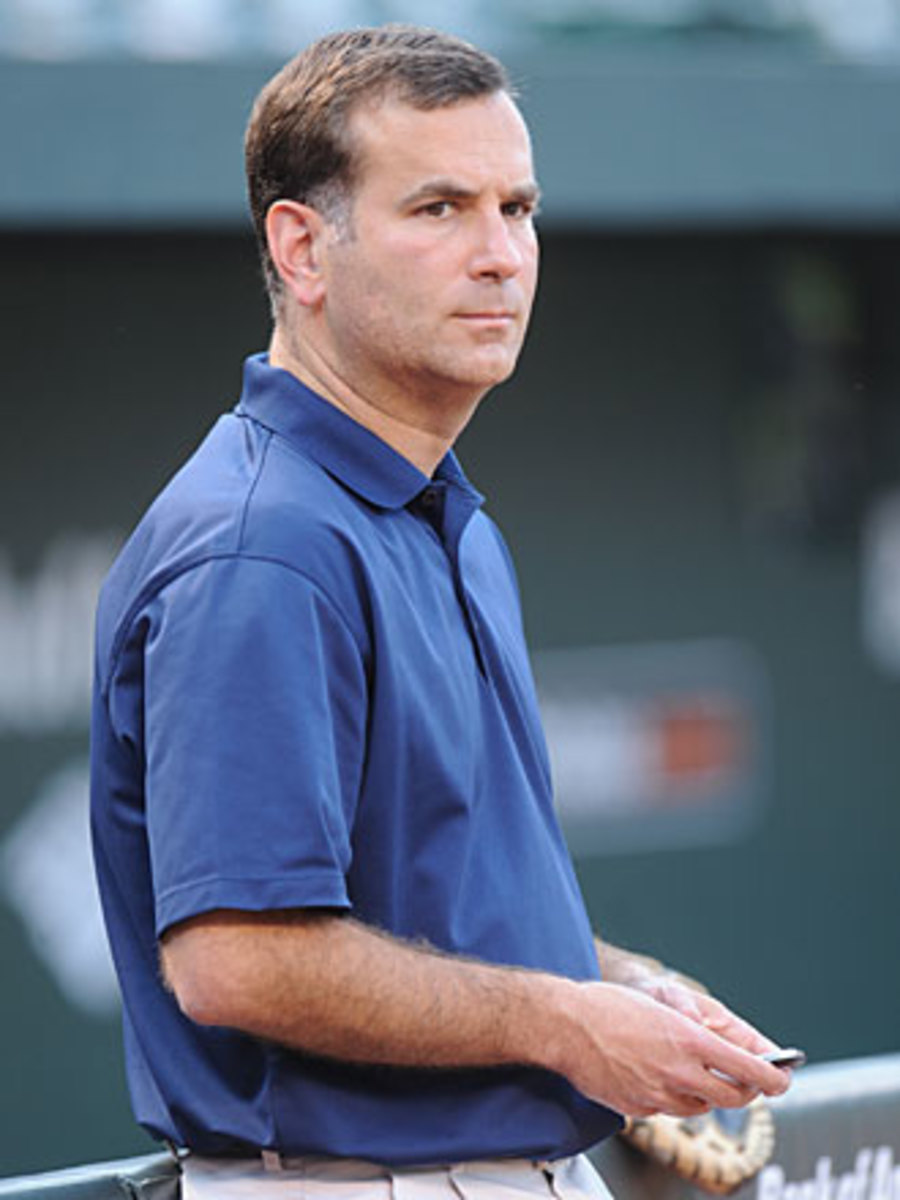White Sox' shrewd improvements have them poised for contention

On the first night baseball's winter meetings, White Sox general manager Rick Hahn was in the middle of dinner at a San Diego restaurant, surrounded by members of the team's brain trust, when his cell phone buzzed. On the other line was A's assistant GM David Forst, an old pal. "Let's get this done," Forst said, referring to a deal that would send Jeff Samardzija to the South Side -- a trade that would solve Chicago's starting rotation problem, shake up the AL Central and set in motion one of the most impressive offseason makeovers of recent winters.
Rewind to a few days after the conclusion of the 2014 season. It had been a dreadful year for the White Sox, who finished fourth in the division with a 73-89 mark and saw their home attendance drop for an eighth straight year. A small group that included Hahn, owner Jerry Reinsdorf, executive vice president Kenny Williams and assistant GM Buddy Bell hunkered down in a room for a series of extended meetings to assess where the organization was, and where it was headed. There was no way around it: The White Sox had more holes to fill than a Chicago highway construction crew. “I’m a little disappointed,” Reinsdorf, the 78-year-old owner who is never one to mince words, said to the others at the summit, referring to how far his team appeared to be from contending. Reinsdorf had another message: I don’t want to hear about a rebuild. Do what you need to do to make this team a contender in 2015.
Hahn and his lieutenants had their work cut out for them. To turn a team that had won 63 and 73 games, respectively, the previous two seasons and had posted the majors' third worst run differential in 2014 into a contender overnight would be no small undertaking. They’d have to be creative, and they’d have to be aggressive — and the Samardzija trade would be a start. After his conversation with Forst in San Diego to iron out the final details — Chicago would be sending righthander Chris Bassitt, catcher Josh Phegley and infielder Marcus Semien to Oakland for Samardzija and lottery ticket Michael Ynoa—Hahn hung up and announced to the group at the restaurant, “We have our No. 2 starter.”
Before anyone could hail the waiter for the Veuve Clicquot, Reinsdorf said, “But what about the other guy?”
Jokes Hahn, “I don’t know how much Jay-Z he listens to, but Jerry certainly understands the concept of ‘Onto the Next [One].’”
The other guy was David Robertson, the ex-Yankees closer coming off a season in which he’d done a fine impersonation of Mariano Rivera in the Bronx. After saving 39 games and posting a 3.08 ERA, Robertson had become a free agent, and the White Sox were closing in. A few minutes later, Hahn’s phone rang, again. It was Robertson’s agent, Scott Leventhal; Hahn stepped outside, reached an agreement on the contract — four years, $46 million — and returned to dinner with the news.
“We have our closer, too,” Hahn said.
With those two deals, struck within minutes of each other and announced that night to a surprised baseball world, the accelerated South Side improvements had begun. Less than a week later, the team signed free agent outfielder Melky Cabrera to a three-year $42 million deal, a surprising move that made it official: the White Sox were the Most Interesting Team of the Off-season.
The Cubs will be the biggest story of spring training on the heels of their headline-grabbing winter in which they hired manager Joe Maddon and signed free-agent lefty Jon Lester. The Marlins, with their megadeal with Giancarlo Stanton and new commitment to winning, will be a popular sleeper pick entering the season. The Padres have undergone a massive overhaul. No team, though, has improved itself more since the end of last season than the White Sox. Having added a top of the rotation starter in his prime (Samardzija), an elite closer (Robertson), an underrated lefty reliever (Zach Duke), an All-Star outfielder (Cabrera), and a grizzled slugger who’s a perfect fit for their ballpark (Adam LaRoche), the White Sox are positioned for a run in 2015, and for the foreseeable future. Asked what AL team has upgraded its roster the most, a rival AL executive said, “I think the White Sox. And in that division, where the Tigers may be taking a step back a little, there’s an opportunity.”
How did this happen? How did an afterthought of a team transform into a dangerous sleeper seemingly overnight? And after such a dreadful two year stretch, why do the White Sox believe that they are talented enough to make a bid for a playoff spot, not only in 2015 but also well beyond?

To know the full story of their turnaround, go back to the 2013 trade deadline and the three-team, six-player deal that sent Jake Peavy from Chicago to Boston and Avisail Garcia from Detroit to Chicago (the Tigers got shortstop Jose Iglesias from the Red Sox). “That was the start of all of this,” says Hahn. Garcia led the Triple A International League with a .374 average in 2013 and, though he played just 46 games in the majors last season — he hit .244/.305/.413 with 7 home runs in 190 plate appearances -- he is still only 24 years old. Garcia be the White Sox' rightfielder in 2015, and the team believes the 6-foot-4, 240 pound Venezuelan who inspires lofty comparisons, can be a middle of the order force perhaps as soon as this year.
Already entrenched in the middle of that lineup is another hulking slugger, 6-3, 255-pound Cuban native Jose Abreu, the reigning AL Rookie of the Year who was signed last offseason when Hahn sought to improve an offense that had finished 2013 ranked dead last in runs. Just weeks after giving Abreu a six-year, $68 million contract, Hahn traded for outfielder Adam Eaton, who missed a bulk of 2014 with injury but showed that he’s a perfect fit in Chicago with his tools (he gets on base atop the order and stabilizes the defense) and his charm.
“We didn’t quite do as much last offseason in terms of volume, but last year was just as significant,” Hahn says.
Despite Abreu’s monster, 36-homer season and another brilliant campaign from Chris Sale, who finished third in CY Young voting, the White Sox improved by 10 wins in 2014 but still wound up 17 games behind first-place Detroit. That would suggest the team still has a long road to contention, but Hahn and the rest of the front office had reason to believe they were close to becoming a winner because of the pieces they did have under control: an elite ace like Sale, a middle-of-the-order masher like Abreu, complementary players like Eaton and an underrated starter in Jose Quintana.
Following the 2014 season, “We were coming off a tough year but also sitting there realizing that we have the prime of Chris Sale's career ahead of us, the prime of Jose Abreu's career ahead of us and we wanted to make sure we were in a position to capitalize and win within that window,” says Hahn.
The White Sox were a clear fit for a Samardzija deal with Oakland; Hahn knew that A’s would be looking for a middle infielder, and reached out to Forst, who was intriguied by Semien. With Samardzija, who posted a 2.99 ERA for the Cubs and A's and made his first All-Star team, the White Sox now have arguably the best 1-2-3 rotation in the AL. In fact, Sale, Samardzija and Quintana totaled a higher WAR in 2014 (14.8, according to Fangraphs) than any that of any top-three in baseball other than the Nationals. In Samardzija Chicago has adding a pitcher who has emerged as a borderline ace and doesn’t have the mileage of a typical 30-year-old after spending the first few years of his career as a reliever. “He’s got the track record, but we’re also seeing that he’ll be a perfect fit in the clubhouse,” says Hahn. “The second or third thing he asked was how he can get access to the complex to start working.”
Winter Report Card: Chicago White Sox
The White Sox could have stopped with Samardzija and Robertson, but the splashy additions to the pitching staff led to a jump in tickets sales — they sold nearly 1,000 season tickets in the days after the deals — motivated Reinsdorf to expand the team's budget in order to sign the Cabrera. “[Cabrera] was always the guy who made most sense for us at the position,” says Hahn. The White Sox had long coveted Cabrera, but early on in the negotiations, it seemed that the one-time All-Star outfielder was somewhat lukewarm about signing with the Sox. On the runway in San Diego heading back to Chicago, Hahn sent Cabrera’s agent, Peter Greenberg, a message that said, “I don’t know how we would pay for this, but I hope that Melky at least sees how we fit and why we want him.”
Before this offseason, the White Sox didn’t have the top of the rotation starter to complement Sale, who finished first in the league in strikeouts per nine innings and second in ERA. Now they have Samardzija. They didn’t have a cleanup hitter, a slugger to complement Jose Abreu, who hit .317/.383/.581 and drove in 107 runs. Now they have LaRoche. They didn’t have a lefty setup man or a viable closer. Now they have Duke and Robertson. They didn’t have an option in leftfield other than Dayan Viciedo. Now they have Cabrera. It’s hard to recall a club that successfully addressed so many questions in a shorter period of time.
The White Sox' moves, of course, weren’t aimed only at 2015, but rather for sustained success. Though the way the fans gushed over the club at last weekend’s SoxFest, however, you may wonder if among the faithful, anything short of a parade next October, the 10-year anniversary of the club’s 2005 championship, would be a disappointment. (“The excitement is great, but there was a part of me that wanted to soft peddle things a bit,” says Hahn.) The leap from a 73-win season to a postseason appearance is a big one. And early projections are skeptical that the White Sox can even get to .500: Baseball Prospectus’ PECOTA peg them as a 78-win club.
But it also doesn’t take much to imagine a scenario where the White Sox emerge as baseball’s surprise team of 2015. If Abreu continues to hammer baseballs like Thor, if Sale can make 30 starts and Samardzija performs to expectations, if Eaton and Garcia have breakout seasons and if the front office can make whatever midseason upgrades are necessary, there’s reason to believe the White Sox can get reach the postseason via the wild card. And the 2014 Giants and Royals were only the latest teams to prove that once a club gets in, you never know what will happen.
In other words, don’t be surprised if the Chicago team that makes the biggest splash in 2015 is the one on the South Side.
